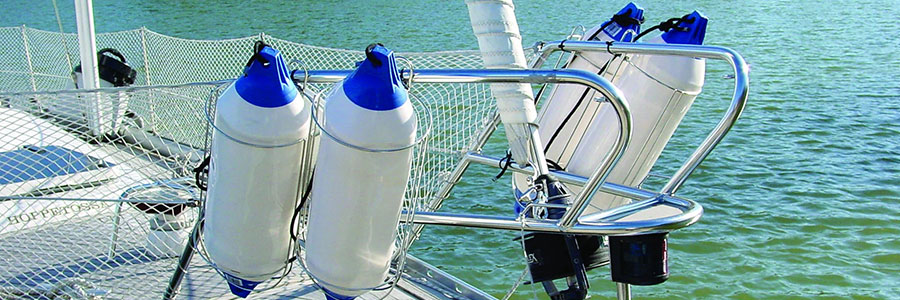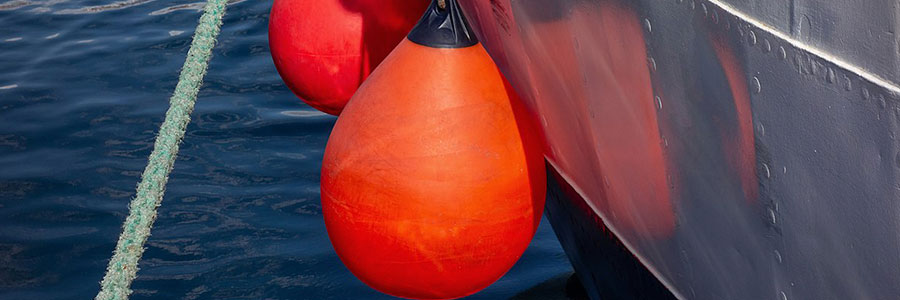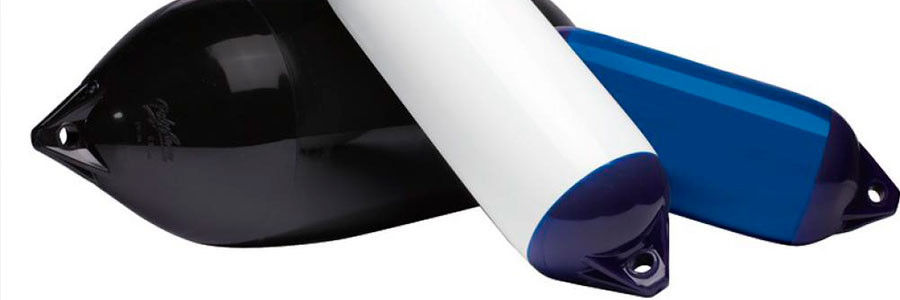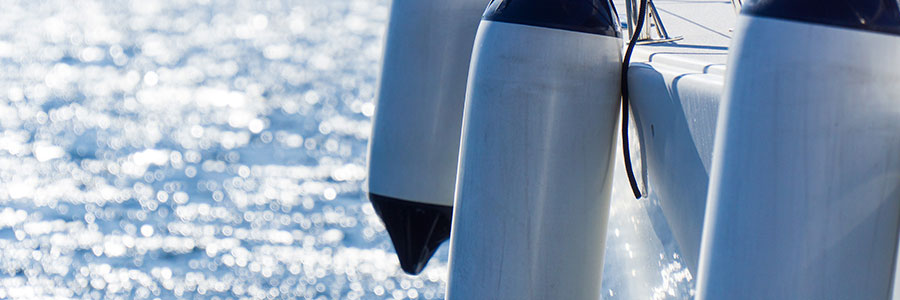Boat fenders are the first line of defense between your prized vessel and the harsh realities of the marine environment. Whether it’s a serene dock on a calm lake or a bustling harbor on the ocean, the potential for your boat to come into contact with docks, pilings, or other boats is ever-present. Fenders, often called boat bumpers, play a crucial role in absorbing and distributing the force exerted upon your boat during these contacts, minimizing damage to your boat’s hull and maintaining its aesthetic and structural integrity.

Understanding How Boat Fenders Work
Boat fenders, essential for protecting the hull of your vessel, act as a cushion between your boat and potential hazards like docks, other boats, or pilings. Their primary function is to absorb the impact and prevent or minimize damage to your boat's sides or hull.
The Mechanism of Impact Absorption
Fenders work on a simple principle: they absorb and disperse the energy from impacts that occur when a boat comes into contact with other objects. Made from materials like soft foam, inflated vinyl, or rubber, fenders are designed to compress upon impact. This compression acts as a buffer, significantly reducing the force that would otherwise be directly transferred to the boat's hull. By dissipating the energy across their surface, fenders protect the boat from scratches, dents, and other forms of damage that can be expensive to repair.
Adapting to Various Mooring Scenarios
Different mooring conditions require specific types of fenders or placement strategies:
- Floating Docks: In this scenario, fenders are usually positioned just above the waterline to create a buffer that accommodates the dock and boat’s movement with the water level. This ensures continuous protection, regardless of tide changes.
- Rafting Up: When boats are moored side by side, fenders are placed at points of contact, usually at the widest part of the beam. This setup allows boats to stay close without damaging each other’s sides.
- Docking Next to Pilings: Pilings can push fenders aside, leading to potential boat damage. The solution often involves using a fender board that spans the distance between pilings, with fenders placed behind the board. This configuration ensures a stable barrier that absorbs impacts and keeps the boat safe.
Customizing Dock Protection
Boats with permanent docking spaces often go a step further in customizing their protective measures. Dock owners might install dock guards, wheels, or cushions on the dock itself, so the boat comes into contact with a soft, forgiving surface rather than a hard one. This method is particularly effective as it ensures the protective gear is always correctly positioned, providing optimal protection.
The Importance of Correct Fender Type and Placement
Choosing the right fender and placing it correctly is crucial for effective protection. Different types of fenders are designed for specific situations:
- Cylindrical and Spherical Fenders: These are versatile and can be used in various docking conditions, absorbing shocks and protecting the boat from all angles.
- Specialty Fenders: Designed for specific conditions, such as low freeboard fenders for boats sitting low in the water, or transom fenders for protecting the boat's stern.
- Fender Boards: Used in conjunction with cylindrical or spherical fenders, they provide a solid barrier against pilings, distributing pressure evenly and preventing fender roll-up.
Understanding how boat fenders work allows boat owners to make informed decisions about the types and arrangements of fenders that will best protect their vessels. By considering the boat's size, docking conditions, and potential contact points, owners can select fenders that will effectively absorb impacts, preserving the beauty and integrity of their boats.
When choosing the right size and type of fender, consider using a boat fender size chart to determine the appropriate dimensions based on the size and weight of your boat. Fender covers can protect your fenders and keep them clean. It's essential to hang fenders at the correct height, typically adjusting the fender line so that the fender is just above the waterline. The rule of thumb for fender placement is one fender for every 10 feet of boat length, ensuring coverage for all potential contact points. Fender accessories, such as fender racks and fender cushions, can help organize and protect your fenders. Inflatable fenders are a great option for smaller boats or for additional protection. Remember, it's better to have too many fenders than too few, as fenders are essential in preventing damage to your boat from another boat or a dock.

Factors Influencing Fender Size Selection
Selecting the correct size for your boat fenders is more than a matter of aesthetics; it's crucial for ensuring the safety and longevity of your boat. Several factors play into choosing the right fender size, each affecting how well the fenders will protect your boat under various conditions.
1. Boat Length and Weight
The size and weight of your boat are the most direct indicators of the size and number of fenders you'll need. Generally, the rule of thumb is to use fenders with 1 inch of diameter for cylindrical fenders or 2 inches for spherical fenders for every 4 to 5 feet of boat length. However, this is a baseline, and heavier boats may require larger or additional fenders to absorb the same amount of impact effectively.
2. Mooring Conditions
The conditions in which you typically moor your boat play a significant role in determining the size and type of fenders you should use. Boats moored in areas with high traffic, strong currents, or choppy waters will experience more forceful impacts and therefore benefit from larger or more fenders. Similarly, the type of docking—whether alongside a dock, a floating platform, or mooring in open water—will influence the best fender setup for your needs.
3. Type of Docking Surfaces
The material and construction of the dock or object your boat will be moored against also influence fender size selection. Rough, abrasive surfaces like concrete or unpolished wood can cause more wear on fenders, necessitating larger or more durable options. Conversely, smoother surfaces may allow for standard-size fenders to provide sufficient protection.
4. Environmental Factors
Environmental factors, including wind and tidal changes, can significantly impact how a boat rests against its mooring points. In areas with significant tidal movement, larger fenders may be necessary to accommodate the vertical range of motion. High wind areas might require additional fenders placed strategically to counteract the wind's pushing force.
5. Fender Placement and Spacing
The effectiveness of your fenders isn’t just about their size; it's also about how and where they are placed. Correct spacing ensures that pressure is distributed evenly along the side of the boat, preventing "pressure points" that could lead to damage. Fenders should be large enough to cover the necessary area without leaving unprotected gaps.
6. Companion Boats
If you frequently moor alongside other boats, the size and type of those vessels will also factor into your fender size choice. Larger fenders or specialized types like rafting cushions might be needed to protect between significantly different hull types or sizes.
Selecting the right size and number of fenders is a balancing act between your boat's characteristics, the mooring environment, and practical considerations like storage space and budget. By carefully evaluating these factors, you can ensure that your boat is protected in most docking and mooring situations, extending the life of your vessel and keeping it looking its best.
When considering which fenders to choose, use a boat fender guide to determine the best boat fender size for your needs. The number of fenders you need for your boat depends on its size and the docking conditions. A common rule of thumb is to have one fender for every 10 feet of boat length. Additionally, consider boat fender accessories like fender whips to suspend the fenders and keep them in place. Vinyl fenders are popular due to their durability and ease of cleaning. Ensure your fenders are at the correct height to provide optimal protection, typically by adjusting the cleat and fender line. Remember, it’s better to have too many fenders than too few to prevent damage to your boat from contact with the dock or other boats.

Types of Boat Fenders and Their Uses
Boat fenders are vital for protecting your vessel against damage while docked or moored alongside other boats. There's a variety of fender types available, each designed for specific uses and conditions. Understanding these types can help you select the right fender for your boating needs, ensuring your vessel remains undamaged in various mooring situations.
1. Cylindrical Double-Eye Fenders
These are among the most common types of fenders, recognizable by their long, cylindrical shape with an eye on each end. They're versatile and can be hung vertically or horizontally, making them suitable for a wide range of boats, especially for protecting the midsection against docks and other vessels.
2. Center Hole Fenders
Designed for durability and convenience, center hole fenders can be hung vertically or horizontally using a single line running through their center. Their design allows for easy adjustment and secure positioning, ideal for larger vessels that require robust protection.
3. Round Fenders
Spherical in shape, round fenders offer high-impact absorption, making them excellent for larger vessels with concave bows or for use as mooring buoys. Their shape allows them to roll with the impact, providing consistent protection regardless of how the boat moves against them.
4. Transom Mounted Fenders
Specifically designed for the boat’s transom or swim step, these fenders offer protection when docking stern-to (Mediterranean style) in a marina. Their unique shape fits the stern's contours, safeguarding the transom area from impacts.
5. Low Freeboard Fenders
Low freeboard fenders sit high on the hull and hang inward over the gunwale, providing protection for boats that sit low in the water, like bass, fishing, and ski boats. Their smaller size and specialized design prevent damage from docks that are higher than the boat’s deck.
6. Specialty Fenders
There’s a range of specialty fenders designed for specific situations, including:
- Rafting Cushions: For boats moored together, offering large surface protection and easy attachment.
- V-Shaped Freedom Fenders: With a self-centering design, ideal for pilings or when multiple boats are docked together.
- Pontoon Fenders: Tailored for pontoon boats, protecting delicate aluminum fencing and corners.
7. Tuff End Fenders
Rugged and large diameter, Tuff End fenders are suitable for flared, deep-V hulls common in large boats and commercial applications. Their heavy-duty design offers superior protection against impacts.
8. Flat Fenders
Flat fenders are either modular or articulating, designed to conform to the boat’s side and provide a broad area of protection. They are particularly useful for boats with limited storage space as they can be stacked or rolled up when not in use.
Choosing the right type of boat fender involves considering your boat’s specific needs, the conditions in which you typically dock or moor, and personal preferences regarding maintenance and aesthetics. Whether you need the versatility of cylindrical double-eye fenders, the robust protection of center hole or Tuff End fenders, or the specialized performance of transom or low freeboard fenders, there's a fender type suited to every boating scenario. By selecting the appropriate fender type, you can ensure your vessel remains protected, maintaining its appearance and structural integrity for years to come.

Matching Fender Size to Boat Size: A General Guideline
Selecting the appropriate size for your boat fenders is crucial to ensure they provide effective protection for your vessel against docks, pilings, and other boats. This guideline offers a foundational approach to match fender size with boat size, incorporating factors like boat length, weight, and mooring conditions into your decision-making process.
Understanding the Basic Ratio
The general rule of thumb for matching fender size to boat size revolves around a simple ratio: approximately 1 inch of fender diameter for cylindrical fenders (or 2 inches for spherical fenders) for every 4 to 5 feet of boat length. This ratio serves as a starting point, but remember, it's the minimum recommended protection. Depending on your specific circumstances, you might need to adjust accordingly.
Boat Length and Weight Considerations
- Lighter Boats: For boats on the lighter side of the spectrum for their length, the basic ratio often suffices. These boats typically don't require as much cushioning to absorb impacts, making standard-sized fenders adequate for most situations.
- Heavier Boats: Heavier vessels exert more force upon impact, necessitating larger or additional fenders to absorb and distribute this energy effectively. If your boat is particularly heavy for its size, consider upsizing your fenders beyond the general guideline to ensure adequate protection.
Mooring Conditions
- Calm Waters: In sheltered waters with minimal wave action and little to no current, sticking close to the guideline should provide sufficient protection.
- Challenging Conditions: For boats moored in areas exposed to high winds, strong currents, significant wave action, or tidal surges, larger fenders or a greater number of fenders are advisable to counteract the increased forces at play.
Fender Placement and Quantity
- Strategic Placement: The placement of fenders is as critical as their size. Ensure fenders are positioned at key contact points along the hull, particularly where the beam is the widest and at any points that protrude or are likely to come into contact with docks or other vessels.
- Adequate Quantity: As a general rule, deploy at least one fender per 10 feet of boat length, with a minimum of three fenders for any boat. This ensures that there are enough points of protection to distribute the forces exerted on the boat during mooring.
Custom Adjustments
Remember, these guidelines provide a foundation but are not one-size-fits-all solutions. Factors such as the boat's design, the docking setup, and personal experience should also inform your final decision on fender size and quantity. Always err on the side of caution, opting for more protection rather than less, to safeguard your investment against potential damage.
Matching the right fender size to your boat size is an essential aspect of boat maintenance and protection. While the basic guideline offers a starting point, always consider the unique aspects of your boating environment and vessel characteristics. Adequate fendering not only protects your boat from damage but also contributes to a stress-free mooring experience, ensuring that your vessel remains secure and in pristine condition.
Conclusion: What Size Boat Fenders Do I Need?
Choosing the right size and number of boat fenders is essential for protecting your boat. The size of the fenders you need for your boat depends on its length and weight, with larger boats requiring bigger fenders. As a general rule of thumb, use one inch of fender diameter for every four to five feet of boat length for cylindrical fenders, and two inches for spherical fenders. Ensure you have enough fenders to cover the critical points of contact between your boat and the dock, and hang the fenders at the correct height to prevent damage. Typically, fenders should be positioned as low as possible to protect your boat's hull effectively.
